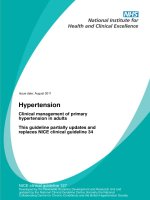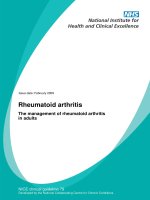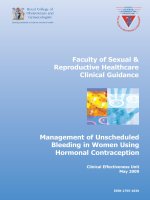Management of breast cancer in women: A national clinical guideline ppt
Bạn đang xem bản rút gọn của tài liệu. Xem và tải ngay bản đầy đủ của tài liệu tại đây (1.49 MB, 52 trang )
Management of breast cancer in women
A national clinical guideline
1 Introduction 1
2 Diagnosis, referral and investigation 2
3 Surgery 7
4 Radiotherapy 13
5 Systemic therapy 16
6 Psychological care 24
7 Follow up 29
8 Information for discussion with patients and carers 31
9 Development of the guideline 35
10 Implementation and audit 38
Abbreviations 40
Annexes 41
References 44
December 2005
84
COPIES OF ALL SIGN GUIDELINES ARE AVAILABLE ONLINE AT WWW.SIGN.AC.UK
84
Scottish Intercollegiate Guidelines Network
S I G N
KEY TO EVIDENCE STATEMENTS AND GRADES OF RECOMMENDATIONS
LEVELS OF EVIDENCE
1
++
High quality meta-analyses, systematic reviews of randomised controlled trials
(RCTs), or RCTs with a very low risk of bias
1
+
Well conducted meta-analyses, systematic reviews of RCTs, or RCTs with a low
risk of bias
1
-
Meta-analyses, systematic reviews of RCTs, or RCTs with a high risk of bias
2
++
High quality systematic reviews of case control or cohort studies
High quality case control or cohort studies with a very low risk of confounding or
bias and a high probability that the relationship is causal
2
+
Well conducted case control or cohort studies with a low risk of confounding or
bias and a moderate probability that the relationship is causal
2
-
Case control or cohort studies with a high risk of confounding or bias
andasignicantriskthattherelationshipisnotcausal
3 Non-analytic studies, eg case reports, case series
4 Expert opinion
GRADES OF RECOMMENDATION
Note: The grade of recommendation relates to the strength of the evidence on which the
recommendation is based. It does not reect the clinical importance of the recommendation.
A
At least one meta-analysis, systematic review of RCTs, or RCT rated as 1
++
and directly applicable to the target population; or
A body of evidence consisting principally of studies rated as 1
+
, directly applicable
to the target population, and demonstrating overall consistency of results
B
A body of evidence including studies rated as 2
++
, directly applicable to the target
population, and demonstrating overall consistency of results; or
Extrapolated evidence from studies rated as 1
++
or 1
+
C A body of evidence including studies rated as 2
+
, directly applicable to the target
population and demonstrating overall consistency of results; or
Extrapolated evidence from studies rated as 2
++
D Evidence level 3 or 4; or
Extrapolated evidence from studies rated as 2
+
Verbatim extract from SIGN 29 published in 1998. This material covers areas that were not
updated in the current version of the guideline.
GOOD PRACTICE POINTS
Recommended best practice based on the clinical experience of the guideline
development group
This document is produced from elemental chlorine-free material and is sourced from sustainable forests
©
Scottish Intercollegiate Guidelines Network
ISBN 1 899893 34 2
First published 2005
SIGN consents to the photocopying of this guideline for the purpose of implementation in NHSScotland
Scottish Intercollegiate Guidelines Network, 28 Thistle Street, Edinburgh EH2 1EN • www.sign.ac.uk
11
1 INTRODUCTION
1 Introduction
1.1 THE NEED FOR A GUIDELINE
1
1.2 REMIT OF THE GUIDELINE
2
(see section 1.5)
1.3 KEY QUESTIONS
1.4 STATEMENT OF INTENT
1.5 REVIEW AND UPDATING
www.sign.ac.uk
Older recommendations taken directly from SIGN 29 are clearly marked with a SIGN
29 symbol and a green font. It should be remembered that these older recommendations
have not been developed with the rigour of current SIGN methodology and the evidence
on which they are based may have been superseded.
2
MANAGEMENT OF BREAST CANCER IN WOMEN
1
+
2 Diagnosis, referral and investigation
2.1 INTRODUCTION
(section 2.2.1); (section
2.2.2)
(section 2.3).
4
6
10
C Women should be encouraged to become aware of the feel and shape of their breasts, so
that they are familiar with what is normal for them.
C Women should be encouraged to report any change from normal to their general
practitioner.
Radiographers
Radiologists
11
11
12
16
4
2 DIAGNOSIS, REFERRAL AND INVESTIGATION
2.2 DIAGNOSING BREAST CANCER
20
18
(see Table 1).
Table 1: Scottish Cancer Group Referral Guideline
Source of
problem
Who to refer Who to manage in primary care
LUMP
PAIN
NIPPLE
SYMPTOM
retraction
SKIN
CHANGES
4
MANAGEMENT OF BREAST CANCER IN WOMEN
2
++
2
++
4
1
+
21
2.3 INVESTIGATION OF SYMPTOMATIC BREAST CANCER
22
B All patients should have a full clinical examination.
B Where a localised abnormality is present, patients should have imaging usually followed
byneneedleaspiratecytology or core biopsy.
B A lesion considered malignant following clinical examination, imaging or cytology alone
should,wherepossible,havehistopathologicalconrmationofmalignancybeforeany
denitivesurgicalproceduretakesplace (eg mastectomy or axillary clearance).
D Patients should be seen at a one-stop, multidisciplinary clinic involving breast clinicians,
radiologists and cytology.
24
C Clear lines of communication should be maintained between the primary care team and
staff in the breast unit.
C The GP should be made aware of the information given to the patient and relatives.
26
A Psychological support should be available to women diagnosed with breast cancer at the
clinic.
2
+
4
C Centres and units should develop an integrated network of cancer care using common
clinical guidelines, management protocols and strategies of care.
Table 2: Summary of investigations
Investigation
40
B In patients with symptomatic disease two-view mammography should be performed as
part of triple assessment (clinical assessment, imaging and tissue sampling) in a designated
breast clinic.
B Mammography is not recommended in women under the age of 35 years unless there is
a strong suspicion of carcinoma.
C Magneticresonanceimagingshouldbeconsideredinspecicclinicalsituationswhere
other imaging modalities are not reliable, or have been inconclusive, and where there
are indications that MRI is useful.
2 DIAGNOSIS, REFERRAL AND INVESTIGATION
6
MANAGEMENT OF BREAST CANCER IN WOMEN
see annex 2
41
4
1
++
1
++
1
++
1
+
3 Surgery
3.1 CONSERVATION SURGERY VERSUS MASTECTOMY
(see section 3.3).
42
44
compared
46
48
3 SURGERY
8
MANAGEMENT OF BREAST CANCER IN WOMEN
2
+
A All women with early stage invasive breast cancer who are candidates for breast
conserving surgery should be offered the choice of breast conserving surgery (excision
of tumour with clear margins)ormodiedradicalmastectomy.
A The choice of surgery must be tailored to the individual patient, who should be fully
informed of the options and who should be aware that breast irradiation is required
following conservation and that further surgery may be required if the margins are
positive.
C Breast conserving surgery is contraindicated if:
the ratio of the size of the tumour to the size of the breast would not result in
acceptable cosmesis
there is multifocal disease or extensive malignant microcalcification on
mammogram
there is a contraindication to local radiotherapy (eg previous radiotherapy at this site,
connective tissue disease, severe heart and lung disease, pregnancy).
C Central situation of the tumour is not a contraindication to conservation, although it may
require excision of the nipple and areola, which may compromise cosmesis.
3.2 BREAST RECONSTRUCTION AFTER MASTECTOMY
C The possibility of breast reconstruction should be discussed with all patients prior to
mastectomy.
3.3 SURGICAL MANAGEMENT OF THE AXILLA
1
++
1
++
4
4
4
3 SURGERY
A Axillary surgery should be performed in all patients with invasive breast cancer.
42
Table 3: Surgical management of the axilla
Procedure
42
10
MANAGEMENT OF BREAST CANCER IN WOMEN
4
2
+
2
++
in some patients
3.4 MANAGEMENT OF DUCTAL CARCINOMA IN SITU
60
61
62
B Women with ductal carcinoma in situ who are candidates for breast surgery should be
offered the choice of lumpectomy or mastectomy.
11
1
++
1
++
1
+
4
2
+
64
66
A Women who have undergone breast conserving surgery should be offered postoperative
breast irradiation.
3 SURGERY
12
MANAGEMENT OF BREAST CANCER IN WOMEN
1
+
4
1
+
68
1
++
1
++
1
++
4 Radiotherapy
4.1 INTRODUCTION
4.2 ADJUVANT RADIOTHERAPY
4 RADIOTHERAPY
14
MANAGEMENT OF BREAST CANCER IN WOMEN
1
+
1
++
1
+
1
+
v
vs
A Radiotherapy should be given following mastectomy or breast conserving surgery to reduce
localrecurrencewherethebenettotheindividualislikelytooutweighrisksofradiation
related morbidity.
4.3 SELECTING THE APPROPRIATE SITE
80
81
D Thesupraclaviculareldshouldbeirradiatedinallpatientswithfourormorepositive
axillary nodes.
4
1
+
1
+
1
+
4
4
1
+
4
84
4.4 SCHEDULING OF RADIOTHERAPY
86
88
4.5 DOSE FRACTIONATION
4 RADIOTHERAPY
16
MANAGEMENT OF BREAST CANCER IN WOMEN
1
++
1
++
1
++
1
+
1
+
5 Systemic therapy
5.1 ADJUVANT CHEMOTHERAPY
100
A All women under the age of 70 years, with early breast cancer should be considered for
adjuvant chemotherapy.
101
104
2
+
1
+
1
+
1
++
4
1
+
106
C Women with oestrogen receptor-positive tumours who receive chemotherapy should be
considered for additional endocrine therapy, especially if they are under 35 years.
5.2 NEOADJUVANT CHEMOTHERAPY
110
111
A Neoadjuvant chemotherapy should be considered for women with large cancers as it
improves the rate of breast conservation and is not detrimental to long term
outcome.
5.3 ANTHRACYCLINE AND TAXANE THERAPY
112
114
Epirubicin
114
2
116
A Anthracyclines should be prescribed in preference to non-anthracycline regimens in the
adjuvantsetting,astheyofferadditionalbenets.Epirubicinmaybepreferredasitcauses
less cardiac adverse effects.
5 SYSTEMIC THERAPY
18
MANAGEMENT OF BREAST CANCER IN WOMEN
1
++
1
+
2
+
1
+
Taxanes
118
A Taxanes should be considered in patients with advanced disease.
5.4 BIOLOGICAL THERAPIES
121
124
C Trastuzumab should be reserved for those patients whose tumours have HER2 over-
expression.
1
+
1
+
2
+
128
2
A Combination therapy of trastuzumab with a taxane is recommended in women with
metastatic breast cancer.
5 SYSTEMIC THERAPY
20
MANAGEMENT OF BREAST CANCER IN WOMEN
1
+
1
+
5.5 VINORELBINE AND CAPECITABINE THERAPY
140
141
142
A Either capecitabine or vinorelbine should be considered for patients with advanced breast
cancer.
21
1
+
1
+
4
1
+
1
++
1
+
1
+
5.6 ROLE OF BISPHOSPHONATES
148
148
A Bisphosphonates should be routinely used in combination with other systemic therapy in
patients with metastatic breast cancer with symptomatic bone metastases. The choice of
agent for an individual patient depends on individual circumstances.
5.7 ENDOCRINE THERAPY
A Premenopausal women whose tumours are not shown to have absent oestrogen or
progesterone receptors should be considered for adjuvant endocrine therapy.
A In premenopausal women with advanced disease, the combination of tamoxifen plus
ovarian ablation should be offered before tamoxifen therapy alone.
5 SYSTEMIC THERAPY
22
MANAGEMENT OF BREAST CANCER IN WOMEN
1
++
1
+
1
++
1
+
1
++
1
+
Adjuvant therapy
Neo-adjuvant therapy
Advanced disease
to
A In postmenopausal women with breast cancer tamoxifen remains the treatment of choice
as initial therapy in the adjuvant setting. If there are relative contraindications to its use
(high risk of thromboembolism or endometrial abnormalities) or intolerance, an aromatase
inhibitor can be used in its place.
A Postmenopausal patients should be considered for a switch to an aromatase inhibitor
aftereithertwotothreeyearsorafterveyearsoftamoxifentherapy.
A In postmenopausal women with advanced disease, third generation aromatase inhibitors
should be considered before either tamoxifen or megestrol acetate.
5.8 TIMING OF SURGERY AND CHEMOTHERAPY
1
+
1
++
1
+
4
160
161
C All treatments for patients with early breast cancer should be started as soon as is practical.
Youngwomenwithoestrogenreceptornegativetumoursmaybenetparticularlyfrom
early initiation of chemotherapy following surgery.
5.9 MANAGEMENT OF MENOPAUSAL SYMPTOMS
162
164
B Megestrol acetate or depot intramuscular medroxyprogesterone acetate may be considered
tocontroltheseverityofhotushesinwomenwithbreastcancer.
5 SYSTEMIC THERAPY









